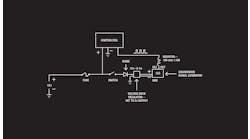Lori Concelman is an accountant by trade. She knows the power of numbers, and how building up the “backend” of data for a business can lead to a cleaner, more efficient company.
That is, if the company has the ability to properly organize the needed information.
When Lori first started working with her husband, Sam, at his family’s Pittsburgh-area repair facility, Glenshaw Auto Service, she quickly noticed the obvious limitations in the business’s shop management software.
“Beyond just being glitchy,” she says, “it didn’t integrate well with anything else. I was using QuickBooks for the accounting side, but it didn’t integrate. So, I was doing all the converting by hand.”
This was in 2006, when Sam first took over the facility full-time from his father. Information wasn’t as easily accessible as the Concelmans needed it to be, and as the shop’s customer base grew larger, they knew they needed a change.
The process of finding shop management software that truly fits a shop’s specific needs is a daunting one, though. According to Michelle Jowers, program manager with ALLDATA, there are more than 175 different software options for shops in the U.S. today, and “obviously, not all of those—or even many of those—are going to be good fits for your shop,” she says.
Every repair facility is different—different sizes, staffs, specialties, clienteles, goals, cultures, etc.—and it is crucial to find a management system that aligns well with your needs.
Know Yourself
After an extensive search, the Concelmans eventually went with Mitchell1’s ManagerSE for their shop.
“It’s not about choosing brand names, though,” Sam warned. “We tested a whole lot of them, and we were looking the whole time for what was going to best fit our needs, not what works best for everyone else.”
That being said, the Concelmans began their search by looking within their own walls. They examined everything from their employee’s work habits to customer expectations to the specific operational metrics they regularly track. They were also in the process of planning a second location (which opened this past spring), and needed to account for how multiple facilities would affect their system.
“We want to be the dealership alternative in our area—the shop that’s right up there with them in quality—and we want our reputation to grow by word of mouth,” Lori says. “We want to give the most professional, yet comfortable, impression to our customers. To do that, we need to be as efficient as possible, and have things streamlined across the board.”
Bottom line: Know your needs before starting the process.
Know What to Look For
Guy Lapierre is the owner of industry consulting firm Forefront Business Solutions and a distributer for Ontario, Canada–based Protractor Software Inc. In discussing Protractor’s shop management software offerings with potential customers, Lapierre says that one thing becomes abundantly clear.
“They usually aren’t even sure what they’re looking for,” he says.
Most shops either stick with the “big names,” or settle on one of the first products they demo.
That’s obviously a large mistake, Lapierre says, and shop owners need to understand what to look for in a system—before they begin the process.
“There are fundamentals that should be present in everything, and then some things that you’re looking for specifically,” he says.
Lapierre, Jowers and the Concelmans say there are several things to consider.
The Basics:
• Simplicity. Complex and elaborate programs have their respective places in business, but Lapierre emphasizes finding a system that you can comfortably work with on a daily basis.
• Data Entry. The system you choose should have simple, easily understandable methods for entering data, Lori Concelman says. And it should have the capacity to record each and every metric you track in your shop.
• Access to Information. The data needs to be easily accessed, and presented in a way that is simple, clear and useful. You should be able to find what you need when you need it, Lori says. Having the ability to look at info-graphics, charts and compile information for use in forecasting is crucial as well.
• Customizable. Sam Concelman says to make sure the system is not a rigid, cookie-cutter product. It needs to have the ability to adapt to your needs, adding and subtracting components as desired.
• Estimating Capabilities. As part of the ALLDATA team, Jowers sees firsthand how some management software doesn’t work well with information systems to provide clear estimates. Shops shouldn’t have to go back and forth between programs or computers to figure out estimates, she says.
• Integration. In fact, Lapierre says shop owners need to evaluate all of the software used in their shops—information services, parts-ordering systems, scheduling programs, etc.—and make sure that it will work seamlessly with any management program they purchase.
• Printing. One very important aspect the Concelmans looked for was the ability to easily print professional-looking, itemized repair documents for customers. Don’t undervalue this aspect, Lori says; it’s likely the only part of this process the customer will have any experience with. Make sure the program allows you to print materials with your company’s branding—including logo and colors.
• Education and Training. The Concelmans take full advantage of the training Mitchell1 offers. They’ve attended sessions themselves and have sent their service writers. Jowers says this may be the most underrated aspect of deciding on a product. You need full-time access to professional help should there be any problems with your system, she says, and the option to take courses, either online or in person, must be considered.
The Next Steps:
• Marketing Capabilities. Jowers says a shop management system can be used as a powerful marketing tool. After all, it stores all of your customer data and information. Some will offer direct mail services; others integrate with email and social media initiatives. Find out what marketing capabilities each program has and how that fits the needs of your shop.
• Mobile Access. Being able to track your shop’s data from afar is a huge benefit to certain programs, Lapierre says. Like many leading management systems, Protractor has a “cloud” component, which allows users to use files and applications over the Internet. Jowers says the best solution is to have a desktop-based platform that can also be accessed from a mobile device.
• Ability to Create Custom Repair Plans. In keeping customer data, Lapierre says the program should be able to help create individual repair and maintenance plans for each customer’s vehicle. Also, the ability to create inspection sheets for technicians, and any other repair-related documents, is a plus, he says.
Test, Test, Test—and Test Again
Any new piece of software is going to come with a learning curve, Jowers says. And just because a system may seem a little tricky at the start doesn’t mean you should discount it.
“None of the systems you try will be particularly easy at first,” Jowers says. “There’s a lot of functionality that goes into even the most basic systems.”
You need to take the time to learn the systems through free demos before making any type of decision, Lori cautions.
The Concelmans tested half-a-dozen systems before making their choice. It’s difficult to describe its direct, tangible impact on the shop’s success, Lori says, but with two shops thriving and growing in revenue and efficiency, the overall impact of finding the right software may be in what they don’t see from it everyday.
“It’s allowed us to grow and do all the things we need to do on a daily basis,” Lori says. “There aren’t extra steps, there aren’t constant problems or glitches. The less we notice it, the better it must be working.”



